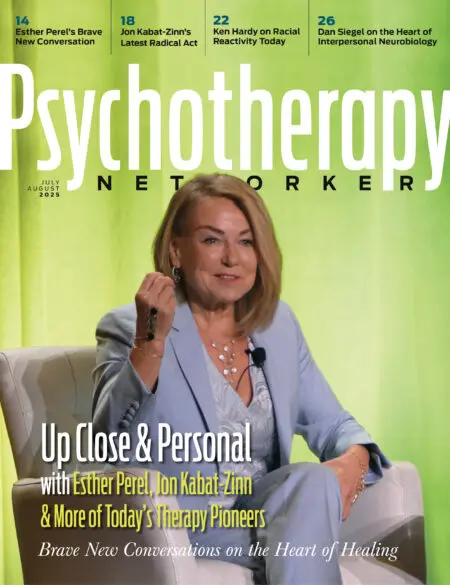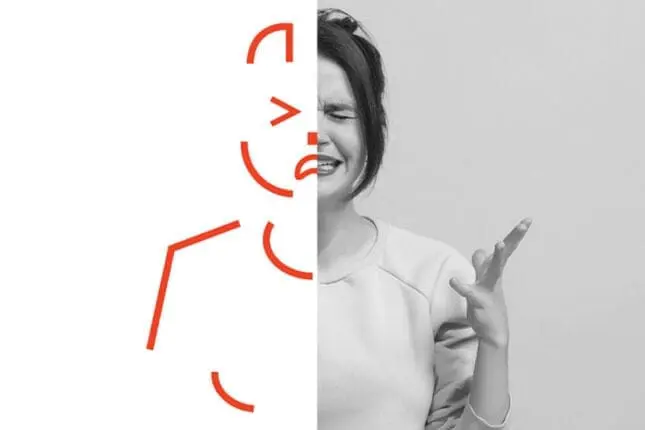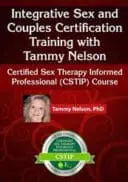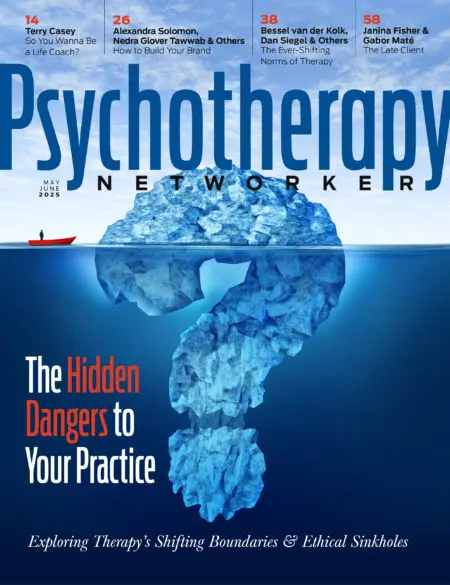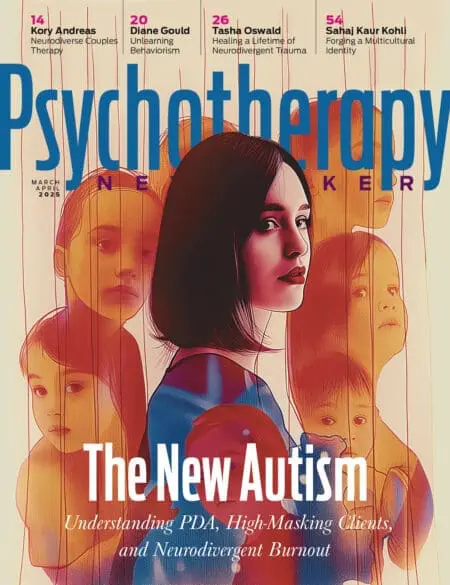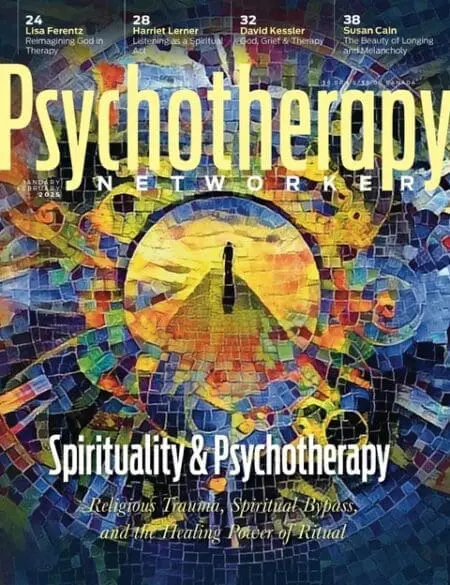Jacki sat in her haphazardly parked car a few blocks from her house,
seething after a tense “happy” hour with friends.
As they’d gathered together, one of Jacki’s friends had let slip some detail about a concert several of them had apparently attended without inviting her. When she heard this, she felt gutted by what she’d later recognize as a familiar ugly knot of exclusion and rejection. Driving home, alone and aided by her increasingly negative story about what happened, her mortification had transformed into rage (a more familiar and thus more comfortable feeling), and she’d impulsively pulled over to write them a text.
Jacki’s thumbs flew across the screen as she furiously typed out her case against them: They knew this was her favorite artist, yet they’d made her feel ridiculous for being upset. She was the one who’d introduced them to his music! They knew she’d been having a hard time and could’ve at least been honest with her—catching them in the coverup was humiliating.
As she paused, Jacki flashed on her friend Grace avoiding eye contact as they’d said goodbye. The image made her stomach roil. Grace was her best friend—how could she, of all people, do this to her?!
Getting her thoughts down gave Jacki a smidgen of relief and propelled her to add more grievances about the others who hadn’t come to her defense. Finally, as a feeling of catharsis took hold, she eased up on typing and a faint whisper of caution emerged. You know you could regret sending a text like this, she thought. What if they get fed up and stop inviting you to things altogether?
But no, their betrayal was too great to go unaddressed. It’s better to be real and fight than be walked on. She inhaled sharply and hit send.
Does Jacki remind you of anyone you know?
The truth is Jacki’s behavior might be regrettable but it’s not uncommon. In retrospect, she could’ve used some help slowing down and getting curious about what had happened and why it upset her before she took retaliatory action, but that’s easier said than done. Once most of us are activated by big feelings like anger and humiliation, being able to acknowledge our automatic defensive patterns and question our interpretation of events is very tricky.
As therapists, we might be tempted to boil down Jacki’s behavior to diagnostic criteria, or to identify her as having an insecure attachment and move on from there—but let’s challenge that categorical thinking. When we label ourselves or our clients as insecurely attached, or avoidant, or preoccupied, or disorganized, we inadvertently lock a fluid, dynamic activation state into something rigid and unchanging, which obscures the beautiful nuance we embody as humans.
Of course, much of the literature on attachment styles comes directly from research that requires us to lump people into categories, so the impulse to label is understandable. But when a therapist believes something about a client is immutable—like personality and temperament—what does that do to our ability to help them? How does that influence our interventions, and therapeutic outcomes?
The Modern Attachment Regulation Spectrum
Does Jacki have a history of insecure attachment? Technically speaking, yes. She was raised by her grandmother, Mimi, while her mother was in and out of addiction treatment. Mimi loved Jacki, but she struggled with depression and was rarely emotionally available to her. Jacki, who knew people could disappear the way her mother had, tracked her grandmother’s moods and became her caretaker to sustain their connection. Her ability to read others became a superpower for her later in life, but anticipating rejection and abandonment in all her relationships creates problems and often leaves her feeling humiliated, rejected, and mistreated—big feelings that seem out of proportion to others.
But there’s good news for Jacki. As her therapists, if we shift our clinical focus from secure attachment to secure functioning, we can create a clear road map for navigating daily life that will help her understand her personal patterns and what she needs to shift them.
Secure functioning is more accessible, and thus potentially more life-changing, than the larger ideal of secure attachment. It’s a state of mind we can return to after becoming dysregulated, rather than a category we either belong to or are left out of. As we learn to recognize our various states of security, we understand how to function securely more often. How?
Built on our integration of modern attachment theory and relational neuroscience, the Modern Attachment Regulation Spectrum (MARS) framework helps clients like Jacki step outside a pathologizing vision of herself. It helps her see that in the lead-up to her sending that unfortunate text, her nervous system had simply shifted away from her connection circuit (secure relating) in favor of her protection circuit (dysregulated, defensive or insecure relating). That’s what made her heart pound and her stomach roil, fueling her certainty about the cause of the problem and the sense of urgency she felt about needing to express her upset.
If we were to measure Jacki’s state using the MARS framework, we’d say she’d flashed into a “red zone.” Her neuroceptive sonar correctly detected a potential relational threat—her friends had gone out without her and her friend Grace was cooler than usual when they parted—and it had sent her attachment system automatically into high alert. Others with a different neural pattern of perceiving events may not have noticed the subtle change in Grace’s demeanor, or they may have noticed and worried about what was going on for Grace.
Notably, we wouldn’t pathologize Jacki’s reaction, nor would we necessarily attach it to any diagnosis. Instead, we’d make sure she understood that dysregulation and insecure functioning is a part of all of us. Even the most securely attached among us can shift into defensively activated, insecure relating. And conversely, those with even the most severe attachment disruptions and challenges can securely relate much of the time.
The idea here isn’t to counter the depth and breadth of over a half century of attachment research, or to invalidate the utility of attachment categories. Instead, we want to help move this research into a clinical framework that can be more useful to more people in their day-to-day lives. After all, each of us can benefit from learning about our nervous system, our interpersonal activation patterns, and the skills required for secure functioning.
The Different Colors of Attachment Activation
When we use the MARS model with clients, we simplify talk about neural circuitry by first teaching about the protection and connection system. If we can help clients notice they’ve left their connection circuit and are actually defensively activated (in their protection circuit), it’s already a huge win.
In Jacki’s case, she might initially be able to say, “Hell yes, I’m activated,” and then have a story to justify her activation. But once she’d spent some time with this framework, she may recognize “Okay, the channel is right, but the volume is too high.” This means she’s not crazy—her friends really did do something without her and others may have also felt left out—but her body is responding in full threat mode. She’s reacting as if their offense is a 10 when it’s arguably more like a 5-7, depending on the details. Confirmation that she’s right (to a degree) can help her feel safe enough to begin to explore her reaction, but scaling the reaction to the offense opens space for curiosity around the intensity of her feelings and reactivity. It points her toward self-reflection instead of self-satisfied blame.
From this vantage point, we can then begin to look at different moments of activation by placing them on a colored spectrum where an arrow shifts between the colors blue, green, and red. This fluid spectrum represents the states of attachment activation created during interpersonal exchanges.
In the middle of the spectrum is the green zone. Here we can think and feel at the same time, consider ourselves and another person, care how we come across, and be flexible and compassionate in our responses. Of course, no one just parks themselves in that secure green zone all the time. It’s more a North Star we paddle toward when we drift away from a secure state. Once clients know what their green zone feels like, it helps them differentiate that secure state from one in which their body is feeling threatened and they become lost in activation.
Secure, green-zone functioning doesn’t mean you have to be “nice.” On the contrary, when we’re in this integrated neural circuit, we can be quite powerful and more effective with our voice, or we can choose not to say something for good reason. Compassion and generosity come easily. We can allow ourselves to be influenced by others’ perspectives without losing ourselves. We can have big feelings and maintain our thinking and care for how we’re coming across to others. Also, even though we call it the connection circuit, secure green-zone relating doesn’t always mean we want or need social engagement. No brain functions exactly the same, and being alone may be the most direct path to that circuit of security for some.
When we’re not in the green zone, we can all experience times of distress as we perceive threats in our relational world. That’s when our protection circuit kicks in, and we tend to rely on the familiar defensive strategies to help us cope with our emotions and tension. Our go-to response patterns, and how often we rely on them, are shaped by our individual and cultural backgrounds, the systems we live in, and our current situation. In MARS, we call those more stable patterns our attachment maps (a slightly broader concept than internal working models).
Some of us, like Jacki, have learned to keep our attachment system on higher alert, with our attention more preoccupied than others with the fear of loss of relationships (red activation). Others can shift more readily toward blue activation in an attempt to deactivate the attachment system entirely. On the blue side of the spectrum, we are more walled off and can lean heavily on our intellect and high reason to justify our anger and actions—which helps us reduce emotional expressiveness in ourselves and shut it down in others. The design is to feel safer, but in fact, shifting blue is often problematic if we believe we’re “fine” and the issue is the emotional person over there. The further blue we shift, the more we lose contact with feelings of connection. This can leave us believing we’re secure when we’re actually in a more brittle defense state due to perceiving quite a bit of threat.
Sometimes, rather than shifting along the green-blue-red attachment-activation spectrum in the face of a relational threat, we might experience a confusing mix of activation and dysregulation. When this occurs, it means we may’ve fallen into a pocket of disorganization represented by a tie-dye puddle that lies underneath the spectrum. While in the puddle, we may recognize a confusing mix of thoughts and feelings or be dropped into numbness and dissociation. The realistic goal when this happens isn’t necessarily to move directly toward the regulated green zone, but to get less disorganized. That means getting clearer about what we’re feeling so that we reconstitute back up to the more predictable spectrum, no matter which color we land in. This puts us on track to feel safer, which is required to be able to shift toward a more regulated state of attachment activation.
MARS Sunglasses
A crucial concept in the MARS framework is the scientific recognition that when we’re dysregulated, our brains actually distort incoming relational information. Keeping this in mind helps clients like Jacki explore these perceptual distortions and the predictable patterns that cause them without the shame that so often comes with emerging awareness.
For example, if our attachment map tends to hang in the secure zone, or if we’re in a secure, green-zone state of mind, we perceive information most accurately. We can take in criticism without amplifying what the other person is saying in a way that makes it more negative than it is, see our own faults without attacking ourselves, and see flaws in others without hyperbole. Think of it as viewing life through clear glasses.
However, as we leave the green zone, our perceptual lens shifts and begins to focus differently. According to brain imaging, when we’re anxiously activated and shift red, we feel emotional communication more deeply, remember painful interactions in more detail and for longer, and tend toward negative interpretations of ambiguous events. Imagine red-tinged, large-rimmed, magnifying sunglasses.
When our attachment activation has downregulated or shifted blue, our glasses do the opposite of the large red glasses: they distort by blocking important relational information, including nonverbal and subtle emotional expressions, from getting in. The fMRI studies indicate we don’t notice and are less likely to remember negative interactions, for example. We miss cues from others and reduce our own emotional expressiveness. Think of cool, dark aviator glasses that interpersonally block in both directions.
And when we’re dysregulated enough that we’ve fallen into a tie-dye puddle, imagine that our sunglasses have been knocked off and everything is blurry. The goal, then, is to move out of disorientation and get any pair of glasses back on so you can begin to identify and organize your thoughts and feelings, a step toward feeling safer.
Here’s the important thing: red zoners aren’t drama queens; blue zoners aren’t callous; being in a puddle makes sense—and Jacki isn’t just “acting out” on the side of the road as she texts. She’s having trouble containing her feelings, is hyperfocused on what she feels is a threatening rupture in her friendship with Grace, and is attempting to move toward that friendship by expressing herself and emoting. Because she learned early on to hold tight so people won’t leave, she’s upset about the feeling that Grace might be pulling away.
For Jacki, the healing path emerged through the re-establishment of safety. In therapy, we helped her identify her actions through a lens based not in right/wrong, but in human biology that makes sense. She was able to compassionately understand her distress and feelings of victimhood. From there, she could shift to a more reflective, curious state of mind, where she was able to explore the roots of her distress in the safety of the therapeutic relationship.
By providing her with some language and a visual model for complex attachment dynamics, we empowered Jacki to recognize her patterns, understand her responses, and see how she might work toward more secure relating in her friendships.
Sue Marriott
Sue Marriott, LCSW, CGP and Ann Kelley, PhD cohost “Therapist Uncensored,” a top-rated podcast with over 11 million downloads across the world and are co-authors of the critically acclaimed “Secure Relating: Holding Your Own in an Insecure World (2024).” Besides accomplishing these projects while married, they maintain a clinical practice out of Austin TX where they raised their three children and a hodgepodge of pets.
Ann Kelley
Ann Kelley, PhD and Sue Marriott, LCSW, CGP cohost “Therapist Uncensored,” a top-rated podcast with over 11 million downloads across the world and are co-authors of the critically acclaimed “Secure Relating: Holding Your Own in an Insecure World (2024).” Besides accomplishing these projects while married, they maintain a clinical practice out of Austin TX where they raised their three children and a hodgepodge of pets.
